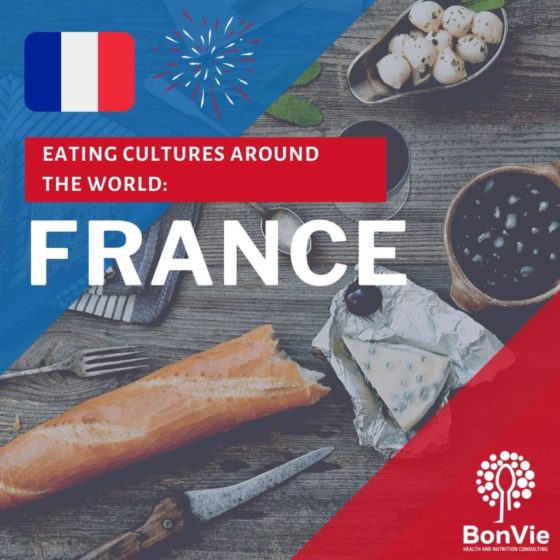
20 Jan Eating Cultures Around the World: France
It’s no secret to anyone who knows me that I’m a devoted Francophile. I was a French minor in college, I’ve been to France 3 times, and I can’t wait to go back someday. I have something French in every room of my house just because it makes me happy (pretty sure I lived there in a past life :)). Heck, I named my health and nutrition company “BonVie” after the French term “le bon vie” (the good life)!
Part of my love for all things French is the strong connection I feel to their love for long, delicious, fresh meals (and the sexy accents there don’t hurt, either – ha!). The French take great pride in the culinary reputation of their nation and fully appreciate the fresh foods they prepare and eat. In general, the French eat 3 times a day with minimal to no snacking in between. However, lunch and dinner are quite large and lengthy!
Usually breakfast is small, consisting of coffee and bread with jam. Lunch and dinner are usually very long and leisurely meals. You’ll never feel rushed in a French café! You can easily hang for 2 to 3 hours.
The French often take a 2-hour lunch break for a meal that can consist of up to 4 courses. It usually includes a soup or salad, entrée, and dessert. It is also not uncommon for people to spend their lunch breaks at home.
Dinner is spent with family around the dinner table, and is often later in the evening (for many as late as 8pm). It follows the same pattern as lunch as far as courses go, but a cheese course is also common during dinner. In France, meat dishes are usually the star of the plate accompanied by vegetables as side dishes. Pasta, potatoes, rice, bread and cheese are also common staples served during lunch or dinner. Pastries or fruit are often served for dessert. The French usually have an alcoholic beverage (typically wine) before a meal and also after a meal. The drink prior to the meal is somewhat equivalent to our version of a “cocktail hour”, whereas after-meal drinks tend to be taken straight. Many feel that it helps to digest the meal, though that’s up for debate, in my opinion.
Although the obesity epidemic is beginning to plague France, the French at one point had an extremely low obesity rate. Many wondered how the French maintained such a low obesity rate despite their love for food, and fatty foods in particular. This was known in media as the “French Paradox”. How did they do this?
Generally, the French eat intuitively, meaning they eat until their bodies give them signals that they are full and they listen to internal cues of fullness and hunger. They have no problem leaving food on their plates and generally do not eat to extreme fullness. The French have carefully prepared meals, which are made of unprocessed, whole ingredients. They do not eat foods that are low-fat, fat-free, or sugar-free like we do in the U.S.
Perhaps most importantly, they are taught at a very young age (in their public educational systems) about the importance of nutrition, food, and maintaining a balanced diet. Even their nursery schools and daycare centers, which are government funded, serve the children homemade, chef-prepared cuisine that is primarily organic, local, and packed with fruits and veggies. Now, that’s what I call living the good life!


No Comments